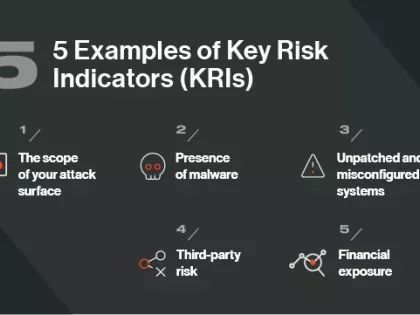Stealer malware is thriving—especially Lumma and Risepro. These logs fuel ransomware, MFA bypass, and persistent access. It's $10 to compromise an account. Explore this and other insights the data reveals.
Be on the Lookout for These Five Common Network Security Threats
Tags:

Common Network Security Threats
Network security threats are constantly evolving, and right now we’re in the middle of a particularly challenging time. While big-name breaches like SolarWinds and others grab headlines, multitudes of smaller incidents continue to occur everyday, costing companies millions of dollars in financial losses, reputational damage, and operational downtime.
The variety of attack methods presents significant challenges for security administrators, who must defend against a wide array of cybersecurity threats and vulnerabilities. To help address these challenges, we’ve compiled a list of the five most common network security threats and included recommendations for mitigating them effectively
1. Ransomware
Ransomware cyber attacks can be profitable and devastating, which makes them extremely popular among hackers. In a ransomware attack, an attacker infiltrates a victim’s network with malware, through a variety of ransomware attack vectors, and essentially holds the network hostage until the victim pays the ransom (usually in Bitcoin, since it’s difficult to trace). This creates a number of issues for the target, including loss of revenue due to downtime and ransom payments and potentially long-lasting reputational damage (the words “cyberattack” and “Colonial Pipeline” will be synonymous for the foreseeable future).
Ransomware incidents can lead to severe consequences, including:
- Revenue loss due to downtime.
- Reputational damage, especially when breaches become public.
- Long-term operational disruption if backups and recovery plans are insufficient.
How to Mitigate Ransomware Risk
The risk of becoming a victim of ransomware can be reduced in a few different ways:
- Maintain robust cybersecurity hygiene. A Bitsight study revealed a strong correlation between poor cybersecurity hygiene and ransomware susceptibility. Having a higher security rating can help. Organizations with low or medium security ratings are six times more likely to experience ransomware attacks.
- Regularly update and patch systems.
- Conduct employee training. Empower users to recognize phishing attempts and other common attack vectors.
- Implement endpoint detection and response (EDR) solutions.
2. Distributed Denial of Service (DDoS) Attacks
The 2021 Verizon Data Breach Investigations Report found that DDoS attacks are the most prevalent form of network security threats. In a DDoS attack, cybercriminals overwhelm a network or website with an immense volume of traffic, causing outages and significant operational disruption. The financial and productivity losses from these attacks can be staggering - and they’re only getting bigger.
How to Mitigate DDoS Risk
Preventing a DDoS attack requires constant vigilance and continuous monitoring of one’s network for anomalous activity. A massive burst of website traffic from unusual sources is a defining trait of a DDoS attack. Employ threat detection tools - like Bitsight for Security Performance Management - to better understand and defend your attack surface. Set up rate-limiting and filtering mechanisms to prevent malicious traffic from overloading systems. Additionally, organizations should use cloud-based DDoS protection services that can handle large-scale attacks.
3. Supply Chain Attacks
Supply chain breaches are increasingly commonplace. Supply chain attacks exploit vulnerabilities in third-party vendors, which can have downstream effects on the organizations they serve. A study by Opinion Matters found that 92% of U.S. organizations have experienced a breach that originated with a vendor.
Challenges of Supply Chain Security
- Lack of visibility. Point-in-time audits and assessments often fail to capture evolving risks.
- Increased attack surfaces. Relationships with third- and fourth-party vendors introduce layers of complexity.
How to Mitigate Supply Chain Risk
- Adopt continuous monitoring solutions to gain near real-time insights into the security postures of vendors.
- Prioritize risk assessment during vendor onboarding
- Monitor fourth-party vendors for a comprehensive view of your supply chain risk surface.
In the wake of large-scale supply chain hacks like SolarWinds, the question of how to understand and mitigate the risk posed by third and fourth parties looms large for all businesses. Cyber security audits and assessments can help, but they fail to provide a complete view of supply chain network security threats. That’s because they only capture a point-in-time and don’t account for evolving risk.
A better option is to use a continuous monitoring solution like Bitsight for Third-Party Risk Management that provides an immediate, near real-time snapshot of the security postures of third parties. The insight can be used to identify cyber risk in the supply chain during onboarding and for the life of the relationship. For a deeper view of risk, Bitsight also brings the capability to continuously monitor fourth parties for a complete view of your organization’s risk surface.
4. Global Business Expansion
This may not crop up on a traditional list of security threats, but businesses that operate across geographies and regions are at heightened risk of cyberattacks due to their complex and large digital ecosystem. Regional inconsistencies in security posture and compliance oftentimes exacerbate this challenge. Additionally, reliance on vendors based overseas increases cyber risk exposure, further complicating cyber risk management efforts.
How to Mitigate Global Risks
- Continuously map and analyze your attack surface to identify hidden vulnerabilities across locations, subsidiaries, and cloud environments.
- Standardize security policies across all regions and ensure compliance.
- Leverage vendor risk management tools to evaluate and monitor international partners.
With this visibility you can then prioritize high-risk assets - like a misconfigured firewall on a server that stores sensitive data - and take action to reduce risk, before the bad guys spot the vulnerability. Using Bitsight for Third-Party Management, you can also expose risk that lies hidden in vendor networks worldwide.
5. Unpatched Applications or Servers
Maintaining a regular patching cadence is one of the easiest things you can do to mitigate network security threats. Yet this basic cybersecurity hygiene measure is often overlooked due to the frequency of updates, the scale of enterprise systems, and a lack of resources.
The consequences can be grave. Outdated or unpatched systems are easy targets for bad actors. In fact, research by Bitsight found that less mature patching programs increase ransomware risk sevenfold.
Take steps to continuously assess your network for unpatched systems, prioritize areas of disproportionate risk, and allocate resources where they have the greatest impact on your organization’s security performance. Bitsight research has shown that organizations with immature patching practices are seven times more likely to fall victim to ransomware attacks.
How to Mitigate Risk
- Establish a regular patch management cadence
- Use vulnerability management tools to continuously assess and prioritize patching efforts
- Address high-risk assets promptly, such as critical systems storing sensitive data
Mitigating Security Threats in Network Security
Each of these common network security threats poses significant risks to your organization’s operations, reputation, and bottom line. All must be considered as part of your strategic cyber risk management program. By understanding these risks and implementing proactive cyber risk management strategies, you can bolster your defenses and reduce exposure to ransomware, DDoS attacks, and other threats.
Conversations about cyber risk management must also extend beyond your Security Operations Center (SOC) to the C-suite. As they plan business expansion, strategic partnerships, and vendor relationships, it’s imperative that senior executives and board members understand the cybersecurity ramifications of their decisions so that they can provide you with the right resources so you can ensure your company is sufficiently protected.
Effective network security threat management extends beyond the Security Operations Center (SOC). It requires:
- Collaboration with the C-suite to align cybersecurity initiatives with business priorities.
- Investments in advanced tools and resources to monitor, mitigate, and respond to evolving threats.
As cybersecurity threats proliferate, fostering a culture of security awareness and resilience becomes critical to ensuring your organization’s long-term success.



